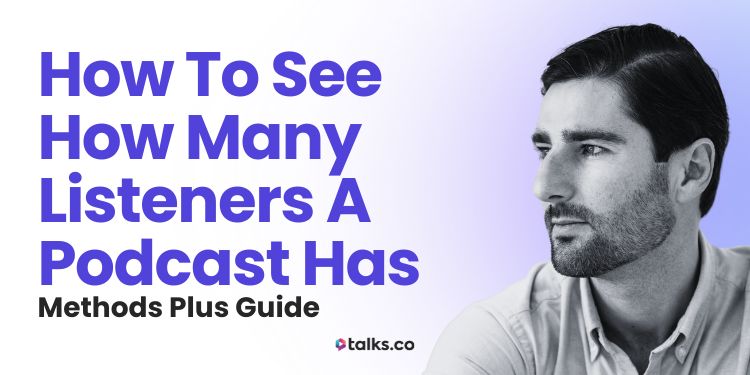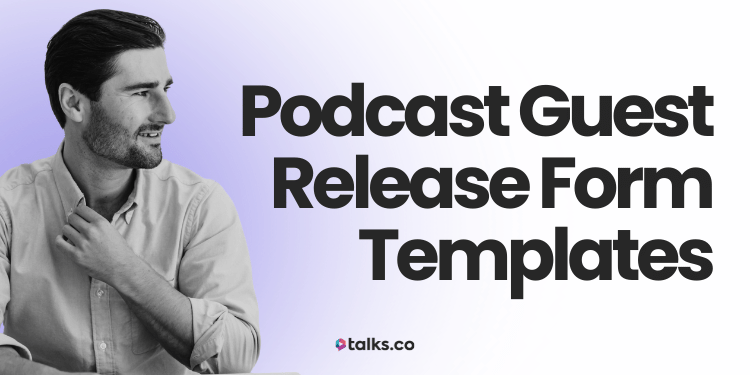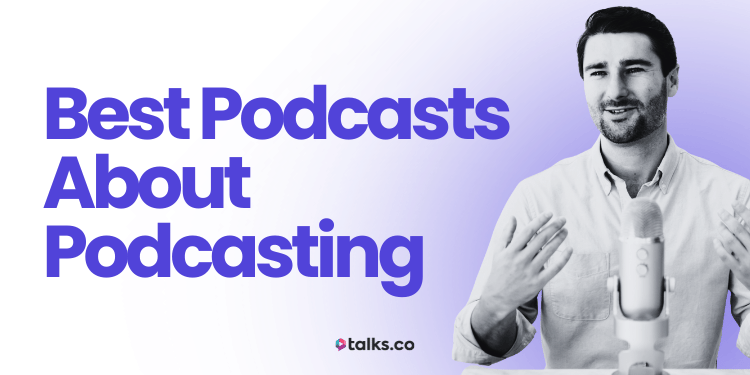If you’ve ever tried figuring out how to see how many listeners a podcast has, you know it’s not exactly as clear as checking Instagram likes.
There’s no one big scoreboard to get these analytics. No public “top scorers” list that shows you the exact number of listeners (unless a host decides to brag about them).
And when you’re trying to pitch yourself as a guest on a podcast, or decide which top podcasts are worth your time, that lack of clarity? Super frustrating.
So it makes perfect sense that you just want straight answers. You want to know which podcasts are actually worth showing up on. You want to make smarter calls with your time and get more visibility without spinning your wheels.
I run Talks, where we help coaches, speakers, authors, and experts like you, get booked on the right shows. And I’ve tested every method under the sun to get a rough idea of how big (or not-so-big) a podcast really is.
So if you’re wondering how to see how many listeners a podcast has, and what those numbers even mean, this is the ultimate guide for you.
15 Ways to See How Many Listeners a Podcast Has
You won’t always find a clean number of subscribers and downloads sitting at the top of a podcast’s profile, but there are plenty of ways to get a solid estimate, especially if you’re thinking about pitching yourself as a guest, collaborating, or just scoping out the space.
Here are ways to know how many listeners a podcast has:
1. Use Castbox’s follower counts
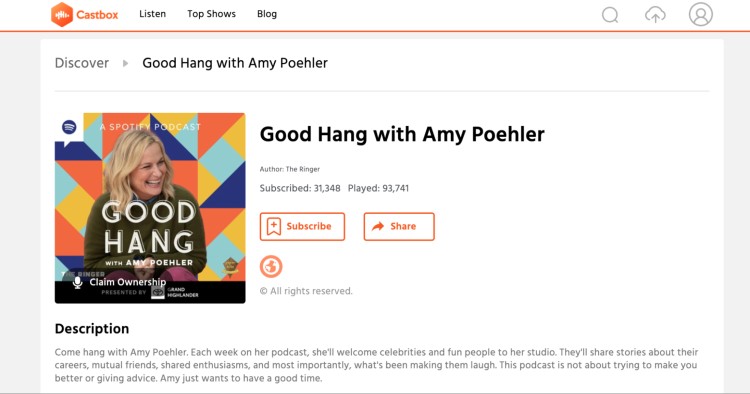
Go to Castbox and search for the podcast. Most podcast pages display the follower count publicly right under the show title.
For example, a podcast show with 50k+ followers on Castbox is likely attracting tens of thousands of downloads per episode across all platforms.
It’s not total listenership, but it gives a clear snapshot of audience size and can help compare similar shows. This is especially useful for independent or niche podcasts.
2. Apple Podcasts rankings and reviews
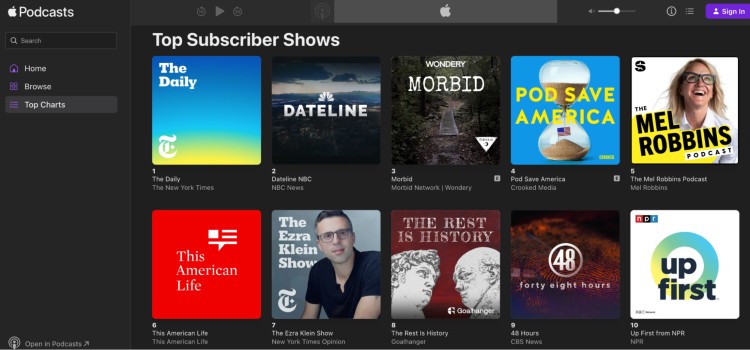
If a show is ranking in the top 100 for its category on Apple, it’s pulling solid traffic. You can also check:
- Total number of ratings
- Review recency and frequency
A popular podcast show with 500+ listener feedback and new ones weekly is likely doing five to ten thousand downloads per episode.
3. Rephonic listener estimates

Rephonic pulls together listener estimates for over 2.5 million podcasts. You’ll see:
- Estimated weekly listeners
- Audience demographics
- Engagement stats
- Social reach
It’s one of the most accurate third-party tools out there and a must if you’re pitching yourself to shows.
4. Listen Notes global rank
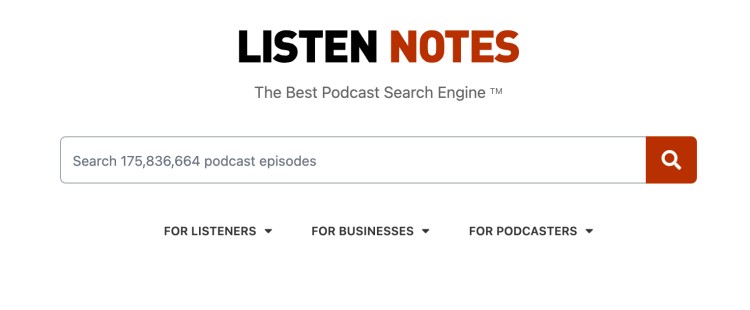
Go to Listen Notes and search for the show. Each podcast has a Listen Score (LS) and Global Rank:
- LS 40+ = top 10% of podcasts.
- LS 50+ = likely getting 10k+ downloads per episode.
Use this to compare shows and identify bigger audiences in your niche.
5. Podtrac verified stats
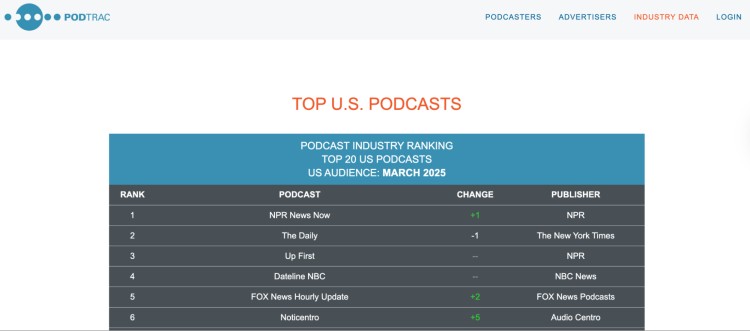
If the podcast is part of the Podtrac Top Publishers or Top Podcasts rankings, you’ll get access to verified numbers such as:
- Monthly unique listeners
- Global reach
- Streams and downloads
This is one of the most credible third-party sources for podcast stats, especially for media companies, large networks, or advertisers. Not every show qualifies, but if they’re listed, it’s a strong sign of high listenership.
6. Podchaser reviews + creator info
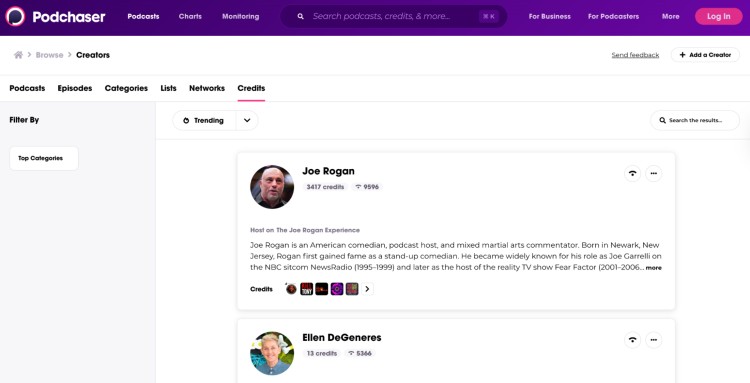
Podchaser is like IMDB for podcasts. You can:
- See episode-level ratings and reviews
- Check guest appearances
- Get a sense of how active and engaged listeners are
Many creators also list podcast download numbers and podcast statistics if they’re pitching sponsorships.
7. Look at their YouTube version (if they have one)

If the podcast is repurposed to YouTube, check views per episode:
- 1k+ views regularly = probably doing well on audio too.
- 10k-50k = likely in the five-figure download range.
Look for consistency across uploads, not just one viral clip.
8. What they say on the show or in the media kit
Pay attention to intros, outros, and sponsor messages. Hosts often say things like:
- “Thanks to our 50,000 weekly listeners…”
- “We just hit one million downloads!”
Also check their website. Many have a Media or Press page with stats and talking points.
9. Engagement on Instagram, TikTok, or LinkedIn
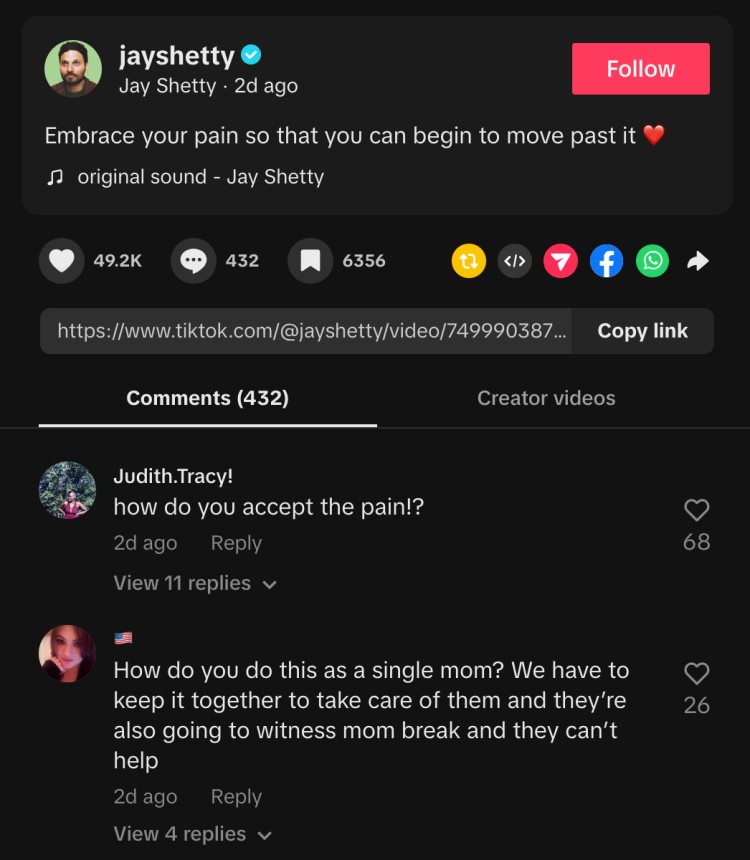
How do people react when they promote their podcast on social media? Do people comment when new episodes drop? Are clips getting saved or shared?
A small show with a loyal, highly engaged audience can be more valuable than a massive but passive one.
Look for:
- Comments from actual listeners.
- Conversations around episodes.
- Shoutouts and tags.
10. Newsletter or community size
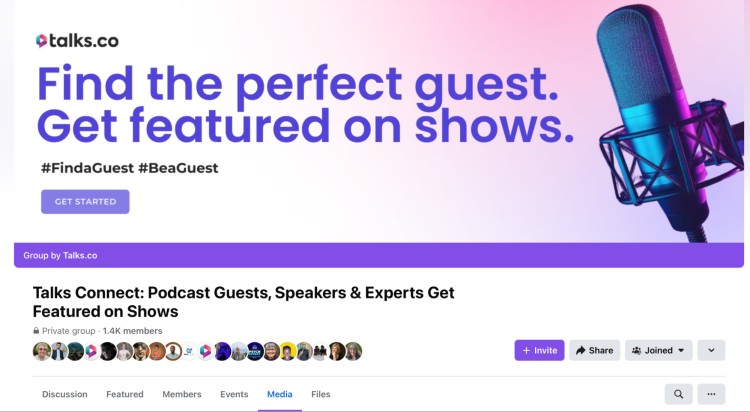
Some podcasters promote their episodes through email or private Facebook groups. Look in their bio, website, or link-in-bio tools for:
- Substack or Kit subscriber counts.
- Discord or Facebook group size.
A podcast tied to a 10k+ email list will usually reflect that (and more) in listener numbers, too.
11. Check how often they publish + consistency
A weekly show that’s been going for two or more years has likely built a loyal listener fan base. Look for:
- Regular episode drops.
- No massive gaps or long breaks.
- Growth in length/production quality over time.
Consistency breeds trust and listens.
12. Review their podcast guests

Big-name podcast guests usually mean big reach. If you’re seeing a number of unique New York Times bestsellers, TED speakers, or verified entrepreneurs on the guest list, the host likely has a sizable audience (or strong connections).
13. Buzzsprout public stats (if they share them)
Buzzsprout is one of the best podcast platforms for monetization. Some podcasters use Buzzsprout and opt to show their episode stats publicly. You’ll see:
- Total number of streams
- Podcast’s performance over time
This isn’t common, but it’s worth checking for the odd one that has it turned on.
14. Download benchmarks by platform
You can also estimate based on public benchmarks:
- Buzzsprout says the average episode gets 125 downloads in seven days.
- 1k = top 20%
- 3k = top 10%
If a host says they’re in the top 5% of podcasts, you can reverse-engineer that into approximately 9k downloads per episode.
15. Ask directly (especially if you’re pitching or sponsoring)
Sometimes, the best way to find out is to just ask:
“Hey [host name], I’m interested in collaborating. Do you have any current audience or download stats you can share?”
Most serious podcasters are open about their numbers (especially if they’re monetizing their podcast or attracting guests regularly).
How to See How Many Listeners a Podcast Has on Spotify
Spotify doesn’t show total plays or unique listeners publicly, but there are still ways to gauge audience size and engagement:
- Check the star rating and number of reviews under the show title. Only listeners who’ve played multiple episodes can leave a rating, so higher numbers = more engaged audience.
- Look at the episode publishing history. Consistent weekly uploads over months or years suggest a committed host and likely a solid listener base.
- Scan the Spotify charts. If the show appears in Spotify’s Top 100 charts (in any category), it’s doing serious numbers. Charts update daily and reflect engagement.
- Watch for shoutouts in the show itself. Hosts often mention download milestones or listener counts casually in episodes or show notes.
Spotify won’t give you the full picture, but paired with outside tools and context clues, it’s still a useful place to start.
How to See How Many Subscribers a Podcast Has
“Subscribers” used to be the main metric in the early podcasting days, but now we look more at followers, downloads, and active listeners.
If you look at Apple or Spotify, both track ratings, not subscribers. You’ll usually need a hosting platform (like Libsyn, Buzzsprout, etc.) to get access to actual follower data if it’s your podcast.
If you’re checking someone else’s podcast, use public-facing indicators like:
- Ratings/reviews
- Chart positions
- Engagement on social
- Mentions in media kits or press features
Bonus tip: Podcasts with consistent weekly releases and solid engagement usually have a loyal subscriber base even if they’re not flashing the numbers.
How to See How Many Subscribers a Podcast Has on Apple
Apple doesn’t show subscriber counts publicly anymore, but you can still get a sense of popularity by:
- Looking at their average ratings and reviews. A podcast with 300+ reviews is likely pulling decent numbers.
- Checking the charts. The top types of podcasts in your niche are ranked based on new followers and downloads, which tells you they’re being listened to consistently.
- Checking Apple Podcasts Preview in a browser. You’ll see recent episode drops and sometimes follower or listen count hints in the description.
- Looking at their Apple Podcasts Connect (if it’s your podcast). That’s where Apple gives data like unique listenership data, number of times listened, and followers who listen to the show.
If you’re evaluating someone else’s show, you won’t get a hard number. But again, combine these with tools like Listen Notes and you’ll be well-equipped.
Why You Should Be Tracking Podcast Stats
Tracking podcast stats isn’t about chasing numbers but making smarter moves with your time, energy, and message.
Whether you’re running your own show or guesting on others, knowing the numbers gives you a clearer picture of what’s working and where to focus.
Here’s why it matters:
- See what’s actually landing. You’ll know which good podcast topics or episodes are getting real attention, so you can double down on what your audience actually cares about.
- Choose the right shows to pitch. If you’re guesting, you want to spend time on shows that have an audience aligned with your niche and goals, like podcasts about podcasting, building a six-figure online coaching business, or starting your own hydroponic garden.
- Track your visibility and reach. You’ll be able to measure your growth and see which shows or strategies are expanding your audience.
- Spot trends early. Stats can help you see patterns before they’re obvious, so you can lead the conversation instead of catching up to it.
- Fine-tune your content. When you know what people are listening to (and what they’re skipping), you can adjust your messaging for more impact.
- Make better promo decisions. Knowing which episodes or interviews perform best helps you decide what’s worth boosting with ads or shoutouts.
- Save time. When you’re clear on what works, you don’t waste energy on what doesn’t.
Tracking stats isn’t about perfection, it’s about progress. You’re not here to guess. You’re here to grow.
How to See Podcast Listener Numbers for Your Own Podcast
If you host a podcast, knowing your listener numbers isn’t just a nice-to-have – it’s essential for growth, content strategy, and monetization.
Here’s how to find your data and what it actually means.
1. Check your podcast hosting platform
Most podcast hosts (like Buzzsprout, Libsyn, Podbean, or Captivate) give you access to listener analytics. You’ll usually see:
- Total downloads (overall + per episode)
- Downloads by time period (7, 30, 90 days)
- Listener locations (by country or city)
- Apps used (Apple Podcasts, Spotify, Audible)
- Device types (mobile, desktop, smart speakers)
Look for patterns like:
- Which episodes performed best.
- Where listeners are dropping off.
- Which platforms bring the most traffic.
2. Use Spotify for Podcasters
If your show is listed on Spotify, head to Spotify for Podcasters. It provides:
- Followers (people who subscribe to your show)
- Unique listeners per episode
- Streams (how often episodes were played)
- Average listen time
- Demographics (age, gender, location)
These metrics are especially valuable if Spotify is a major traffic source for your show.
3. Check Apple Podcasts Connect
Apple doesn’t show public listener numbers, but as the host, you can access your own show’s data via Apple Podcasts Connect. Inside, you’ll find:
- Listeners (unique people who played your show)
- Plays per episode
- Average consumption (how much of the episode was heard)
- Device and region data
Tip: A higher average consumption rate can be more impressive to sponsors than download volume alone.
4. Compare across platforms
Your hosting platform aggregates data, but you can also cross-check directly in:
- Google Podcasts Manager
- Amazon Music for Podcasters
- YouTube Studio (if your podcast is on YouTube)
Each gives platform-specific insights that help you spot where your audience is growing fastest.
5. Use podcast analytics tools for deeper insights
Third-party tools like:
- Chartable (for tracking performance and attributions)
- Podtrac (used by many larger networks)
- Rephonic (audience overlap + network insights)
These are great if you’re pitching to sponsors or want more advanced analytics than your host provides.
6. Look beyond downloads
Downloads are helpful, but don’t tell the full story. Track:
- Follows/subscribers
- Listener retention
- Episode drop-off rates
- Audience growth trends
These give you a better sense of real engagement and help guide your content and marketing strategy.
How to Get More Podcast Listeners
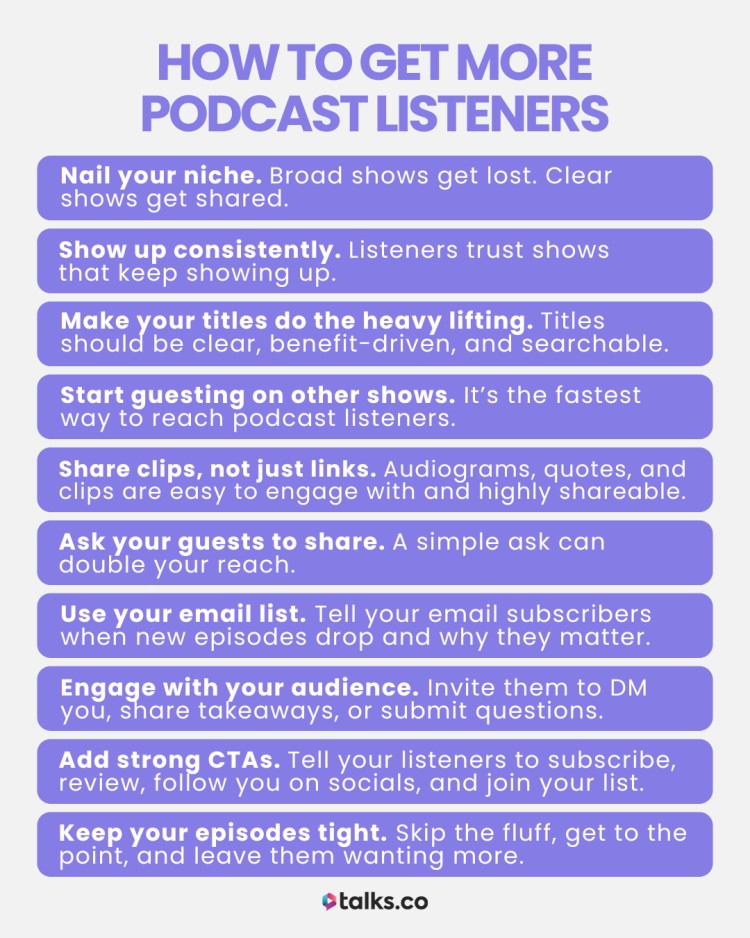
You don’t need a massive budget or a marketing team to grow your podcast. What you do need is a clear message, consistency, and a few smart strategies that actually move the needle.
Here’s what works:
- Nail your niche. The more specific your topic, the easier it is for listeners to know your show is for them. Broad shows get lost. Clear shows get shared.
- Show up consistently. Weekly. Fortnightly. Whatever you choose, stick to it. Listeners trust shows that keep showing up.
- Make your titles do the heavy lifting. Your episode titles should be clear, benefit-driven, and easy to search. You’ve got seconds to grab attention.
- Start guesting on other shows. It’s the fastest way to get in front of people already listening to podcasts. And if you’re a good guest who knows how to do a podcast interview, they’ll want more of you.
- Share clips, not just links. Audiograms, quotes, or short video clips from your episodes are easier to engage with and more likely to get shared.
- Ask your guests to share. A simple ask can double your reach. Make it easy for them by giving them graphics or snippets to post.
- Use your email list. Don’t just publish and hope for the best. Let your email subscribers know when new episodes drop and why they should care.
- Engage with your audience. Invite them to DM you, share takeaways, or submit questions. When people feel heard, they’re more likely to keep listening.
- Add strong calls to action. Tell your listeners what to do next: subscribe, review, follow you on socials, and join your list. Don’t leave it to chance.
- Keep your episodes tight. Respect your listeners’ time. Cut the fluff, get to the point, and leave them wanting more, not skipping ahead.
Growing your podcast isn’t about going viral. It’s about building trust, one episode at a time.
Listeners = Leverage
Want to know the real reason people care about how to see how many listeners a podcast has? Because numbers give you direction. They help you stop spinning your wheels on shows that aren’t moving the needle and double down on the ones that are.
Whether you’re pitching yourself as a guest or growing your own podcast, listener data gives you clarity. You start making choices that actually grow your audience and authority, instead of guessing what might work.
And if you’re serious about getting in front of the right listeners, Talks makes that easier.
You can search podcasts by niche, filter by audience size, and start getting featured on shows that actually fit.
Create a free Talks Creator Profile and start showing up where it counts.
